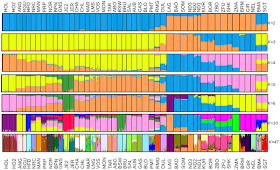
The congruence of cattle breeds with inferred clusters is remarkable. K=47 frappe analysis is probably testing the limits of human visual perception...
PLoS ONE 5(9): e13038. doi:10.1371/journal.pone.0013038
Insights into the Genetic History of French Cattle from Dense SNP Data on 47 Worldwide Breeds
Mathieu Gautier et al.
 Abstract
AbstractBackground
Modern cattle originate from populations of the wild extinct aurochs through a few domestication events which occurred about 8,000 years ago. Newly domesticated populations subsequently spread worldwide following breeder migration routes. The resulting complex historical origins associated with both natural and artificial selection have led to the differentiation of numerous different cattle breeds displaying a broad phenotypic variety over a short period of time.
Methodology/Principal Findings
This study gives a detailed assessment of cattle genetic diversity based on 1,121 individuals sampled in 47 populations from different parts of the world (with a special focus on French cattle) genotyped for 44,706 autosomal SNPs. The analyzed data set consisted of new genotypes for 296 individuals representing 14 French cattle breeds which were combined to those available from three previously published studies. After characterizing SNP polymorphism in the different populations, we performed a detailed analysis of genetic structure at both the individual and population levels. We further searched for spatial patterns of genetic diversity among 23 European populations, most of them being of French origin, under the recently developed spatial Principal Component analysis framework.
Conclusions/Significance
Overall, such high throughput genotyping data confirmed a clear partitioning of the cattle genetic diversity into distinct breeds. In addition, patterns of differentiation among the three main groups of populations—the African taurine, the European taurine and zebus—may provide some additional support for three distinct domestication centres. Finally, among the European cattle breeds investigated, spatial patterns of genetic diversity were found in good agreement with the two main migration routes towards France, initially postulated based on archeological evidence.

Very interesting when we consider that the similarity 9and differences) between pure breeds in agriculture and a species has been a subject for insight and debate since Darwin.
ReplyDeleteA pure breed is an artificially closed sub-population - almost like a sped up and forced attempt to create a speciation. Darwin noted all kinds of observations about what this could end up meaning.
The fact that domesticate breeds of this species can be split cleanly to such a high K number (compared to wild populations of other animals) has a reason, and to me it makes sense given what it is that animal breeders generally aim at?
Daniel Bradley showed much the same divisions way back in a 1996 paper on cattle mtDNA.
ReplyDeleteI've long argued that we should consider 'breeds' to be much the same as 'subspecies'. They exhibit much the same characteristics, and are formed in much the same way: genetic isolation.
I've long argued that we should consider 'breeds' to be much the same as 'subspecies'. They exhibit much the same characteristics, and are formed in much the same way: genetic isolation.
ReplyDeleteI see no difference between breeds and subspecies genetically, physically and anatomically.
Maybe human promoted breeds are amongst the clearest cases of subspecies? :)
ReplyDeletePossibly so.
ReplyDeletePossibly so.
ReplyDeletePossible, yes.
Notice that at K=47, one breed GNS (Guernsey) seems to split into 2 distinct breeds, a Red and a Blue one - strange??
ReplyDeleteAlso, a pertinent map of the dispersal routes is here:
http://www.plosone.org/article/fetchObject.action;jsessionid=191110A76ED7AD2CE763E4318BB00411.ambra02?uri=info%3Adoi%2F10.1371%2Fjournal.pone.0013038.g005&representation=PNG_M
It's a pity that some Cypriot, Italian, Sicilian, Iberian and North African breeds of cattle were not included, as the proposed migration pattern gives 2 main routes into Europe:
1. Danubian - overland from Balkans
2. Mediterranean - ??
But we don't know how the Mediterranean route came about, was it via:
1. Fast boat from Anatolia/Levant
2. Slow boat, island hopping across the Mediterranean Sea, or
3. Overland across North Africa, then up through Iberia.
The difference could be determined by comparing Western French to Iberian and Italian cattle, as if Western French are similar to the other 2, then the route is probably by boat.
However if the Western French are similar to Iberian and North African, then the route would be overland via North Africa.
IMO, this is important for the R1b spread in Europe.
"Possible, yes".
ReplyDeleteAnd much the same as human 'races'.
And much the same as human 'races'.
ReplyDeleteAs I have written many times on this blog, I consider not just breeds but also races (including human races) as subspecies, as I see, likewise, no difference between races and subspecies genetically, physically and anatomically.